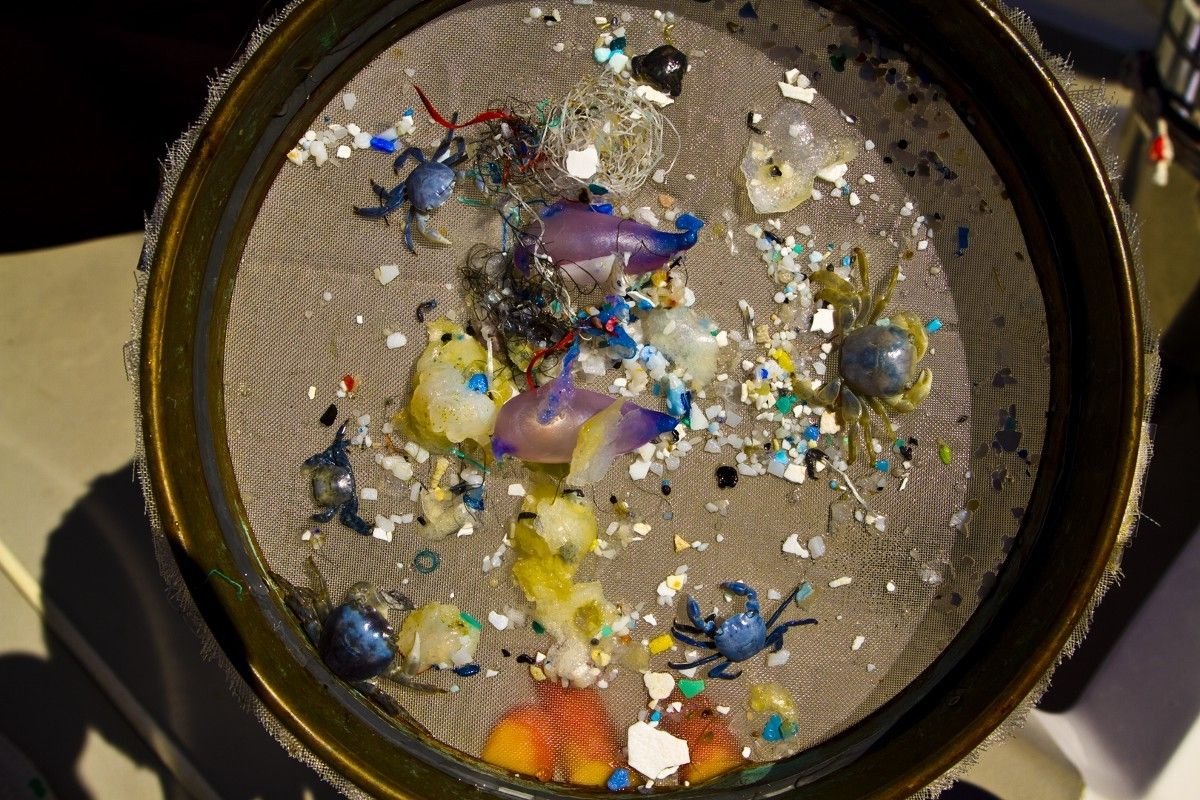
Environmental scientist Marcus Eriksen has sailed all over the world, and everywhere he goes, he finds plastic garbage. Although, to be fair, he's looking for it—and recording what he finds.
Over the course of more than six years and 24 expeditions, Eriksen and a team of collaborators have combed the seas to see just how much plastic debris is floating on the surface out there. And they've finally come up with an estimate: There are 5.3 trillion pieces of plastic, weighing nearly 270,000 tons, on the surface of the world's oceans. That's roughly equivalent to the weight of 570 fully loaded Boeing 747s.
The vast majority of this buoyant waste, more than 90 percent, is very small—less than 5 millimeters in width (or about a third the diameter of a dime).
One of the biggest surprises of the study, published today in the journal PLOS ONE, is that plastic trash in the ocean is being broken apart more extensively and quickly than scientists had thought. In fact, they found 100 times less of these so-called microplastics than expected, says Eriksen, who works with an environmental and research organization called 5 Gyres. It's named after the five major gyres, or swirling patterns in the middle of oceans, where much of the world's floating trash ends up, he says.
But the fact that there's less plastic floating on the ocean's surface than previously though is not necessarily a good thing. What's happening, Eriksen explains, is that the churning motion of the gyres, along with waves and wind and so forth, shred plastic waste relatively quickly. These tiny bits of plastic then leave the surface two major ways.
Plastic Pollution in the World's Oceans from Chris Jones on Vimeo.
First, they get small and they sink, encountering deeper water currents that take them all over the ocean. Second, they are eaten by scores of different animals and organisms, including barnacles, zooplankton, fish, birds and whales, says Chelsea Rochman, an ecotoxicologist at the University of California-Davis who wasn't involved in the study.
This is concerning, since plastics accumulate toxins that were already present in the ocean, and transfer them to the animals that end up eating these small particles.
"Plastic in the ocean is basically a hazardous waste, as it absorbs this plethora of persistent chemical wastes and…delivers these toxins to these animals that unknowingly ingest them," Eriksen says.

Rochman has done laboratory experiments showing that if fish eat plastic contaminated with flame retardants (a persistent pollutant found in the oceans and in the blood of 97 percent of Americans), they become sick. They show signs of endocrine disruption, tumor formation and malformed gonads. It stands to reason this is also happening in the wild, and that plastics may serve as a vector to transfer pollutants into fish, and then perhaps the humans who eat these fish, Rochman says.
Some of the plastic trash in the ocean is recognizable. Eriksen has found all sorts of strange things during his cataloging of plastic garbage. He finds plastic green army men all over the place, and regularly comes across action figure parts, toothbrushes, buoys and fishing equipment. "I also found a toy gorilla 500 miles north of Hawaii," he says.
But, contrary to popular conceptions of the ocean being polluted with large consumer objects, it is actually mostly filled with tiny bits, Eriksen adds. The Great Pacific Garbage Patch, found in one of the five oceanic gyres, contains so many microplastics that the water looks like its "filled with confetti," Rochman says.
These tiny pieces of plastic present more of a problem, in some ways, than larger pieces, Eriksen says. For one, they are easier to ingest. But they are also harder to clean up. It would be impossible to retrieve a significant portion of the garbage now found in the ocean, he says.
The study only estimated the amount of plastic floating on the surface of the oceans. Much more is likely on the ocean bottom, but nobody knows exactly how much there may be, he adds.
The solution to plastic pollution is better waste-management practices on land, Eriksen says. He advocates for alternatives to plastic bags and other plastic products. And he says that the problem won't be solved unless manufacturers offer some incentive to the retrieval and recycling of plastic products.
"We have to redesign all plastic products to be 100 percent recoverable or harmless to the environment," he says.
Uncommon Knowledge
Newsweek is committed to challenging conventional wisdom and finding connections in the search for common ground.
Newsweek is committed to challenging conventional wisdom and finding connections in the search for common ground.
About the writer
Douglas Main is a journalist who lives in New York City and whose writing has appeared in the New York ... Read more
To read how Newsweek uses AI as a newsroom tool, Click here.








